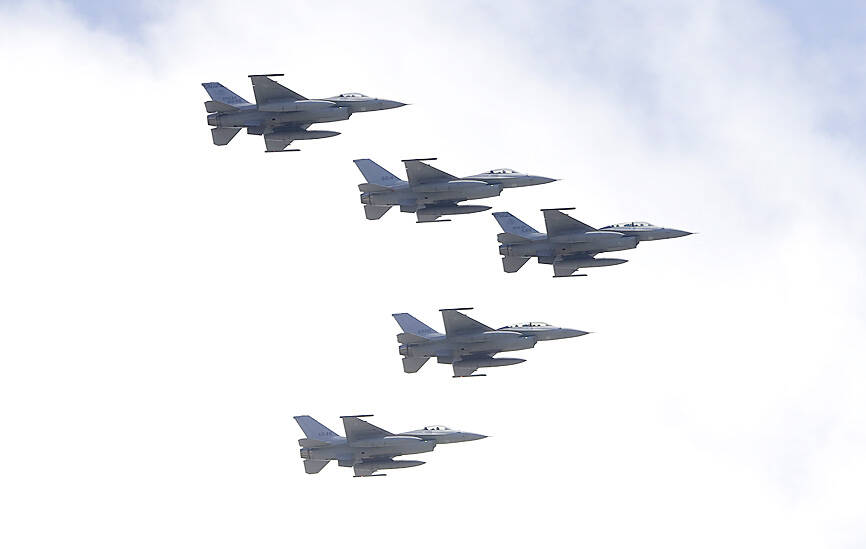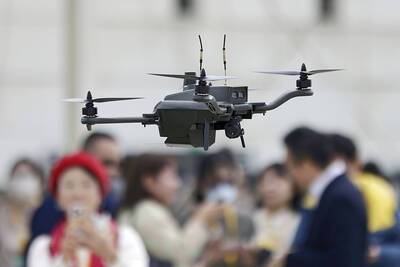Washington informed Taiwan that it has approved a package of up to US$619 million for equipment and munitions related to F-16 jets, the Ministry of Foreign Affairs (MOFA) said yesterday.
The US Department of State notified the US Congress that it has approved the sale, which is likely to pass a vote in Congress within in a month, the Ministry of National Defense said in a statement.
The defense ministry expressed its “sincere gratitude” to the US for approving the sale.

Photo: AP
The package would provide 100 AGM-88B high-speed anti-radiation missiles (HARM), 23 HARM training missiles, 200 AIM-120C-8 advanced medium-range air-to-air missiles (AMRAAM), four AIM-120C-8 AMRAAM guidance systems and 26 LAU-129 multi-purpose launchers, the US Defense Security Cooperation Agency said.
Other munitions and equipment in the package include LAU-118A missile launchers with an aircraft launcher interface computer, HARM missile containers, AIM-120 control sections and containers, AIM-120C captive air training missiles, dummy air training missiles, integration and test support and equipment, and other related elements of logistical and program support, it added.
The main contractors of the missiles would be Raytheon Technologies Corp and Lockheed Martin Corp.
The defense ministry said that the air force has completed combat capability assessments with the AGM-88B and AIM-120C-8 missiles, which are able to further strengthen the defense capabilities protecting Taiwan’s airspace.
The sale also demonstrates Taiwan’s ability to predict the nation’s combat needs and strengthen its armed forces accordingly, it added.
Taiwan is “preparing for war, but not asking for war,” and is determined to boost its self-defense capabilities, the defense ministry said.
The sale is highly welcome, MOFA spokesman Jeff Liu (劉永健) told a news conference yesterday.
The foreign ministry thanked the US for fulfilling its promise in the Taiwan Relations Act and the “six assurances,” he said.
This is the first military sale announced this year by US President Joe Biden’s administration and the eighth in his term, Liu said.
The US continues to normalize arms sales to Taiwan, helping the nation to obtain defense equipment in a timely manner and enhance combat capabilities, he said.
In the face of China’s military expansion, Taiwan would continue to improve its self-defense capabilities and deepen its security relationship with the US, he said.
The sale comes as the defense ministry yesterday reported a second day of large-scale Chinese air force incursions into the nation’s air defense identification zone, with 21 aircraft spotted over 24 hours ending yesterday morning.
The aircraft, 17 J-10 fighters and four J-16 fighters, flew into the southwestern corner of the zone, a defense ministry graphic showed.
The J-10s, an older model that entered service two decades ago, flew closer to the Chinese coast than Taiwan’s, while the J-16s, a much newer and more advanced fighter, flew northeast of the Pratas Islands (Dongsha Islands, 東沙群島), the graphic showed.
Taiwanese air force jets were sent to monitor the Chinese aircraft, the ministry said.
The ministry on Wednesday reported 19 Chinese aircraft flying in the zone.
None of the aircraft crossed the median line of the Taiwan Strait, although 10 Chinese aircraft crossed the line on Friday last week.
Additional reporting by Reuters

The combined effect of the monsoon, the outer rim of Typhoon Fengshen and a low-pressure system is expected to bring significant rainfall this week to various parts of the nation, the Central Weather Administration (CWA) said. The heaviest rain is expected to occur today and tomorrow, with torrential rain expected in Keelung’s north coast, Yilan and the mountainous regions of Taipei and New Taipei City, the CWA said. Rivers could rise rapidly, and residents should stay away from riverbanks and avoid going to the mountains or engaging in water activities, it said. Scattered showers are expected today in central and

COOPERATION: Taiwan is aligning closely with US strategic objectives on various matters, including China’s rare earths restrictions, the Ministry of Foreign Affairs said Taiwan could deal with China’s tightened export controls on rare earth metals by turning to “urban mining,” a researcher said yesterday. Rare earth metals, which are used in semiconductors and other electronic components, could be recovered from industrial or electronic waste to reduce reliance on imports, National Cheng Kung University Department of Resources Engineering professor Lee Cheng-han (李政翰) said. Despite their name, rare earth elements are not actually rare — their abundance in the Earth’s crust is relatively high, but they are dispersed, making extraction and refining energy-intensive and environmentally damaging, he said, adding that many countries have opted to

SUPPLY CHAIN: Taiwan’s advantages in the drone industry include rapid production capacity that is independent of Chinese-made parts, the economic ministry said The Executive Yuan yesterday approved plans to invest NT$44.2 billion (US$1.44 billion) into domestic production of uncrewed aerial vehicles over the next six years, bringing Taiwan’s output value to more than NT$40 billion by 2030 and making the nation Asia’s democratic hub for the drone supply chain. The proposed budget has NT$33.8 billion in new allocations and NT$10.43 billion in existing funds, the Ministry of Economic Affairs said. Under the new development program, the public sector would purchase nearly 100,000 drones, of which 50,898 would be for civil and government use, while 48,750 would be for national defense, it said. The Ministry of

UNITED: The other candidates congratulated Cheng on her win, saying they hoped the new chair could bring the party to victory in the elections next year and in 2028 Former Chinese Nationalist Party (KMT) lawmaker Cheng Li-wun (鄭麗文) yesterday won the party’s chair election with 65,122 votes, or 50.15 percent of the votes. It was the first time Cheng, 55, ran for the top KMT post, and she is the second woman to hold the post of chair, following Hung Hsiu-chu (洪秀柱), who served from 2016 to 2017. Cheng is to succeed incumbent Eric Chu (朱立倫) on Nov. 1 for a four-year term. Cheng said she has spoken with the other five candidates and pledged to maintain party unity, adding that the party would aim to win the elections next year and